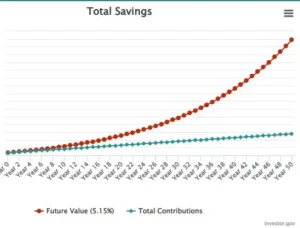While many people purchase life insurance for the death benefit protection that it provides, there are numerous other reasons to include this financial vehicle in your portfolio. One of these is the tax-deferred savings that certain types of life insurance policies can offer.
In some cases, for instance, growth of the cash value in a permanent life insurance policy may be based on more than just an interest rate that is set by the insurance company.
As an example, there are some types of permanent life insurance policies, such as participating whole life insurance, that also pay out dividends to their policyholders – and these can help to boost the cash value growth.
Several economic factors can have an influence on whole life insurance dividends over time, though, including the rise and fall of inflation.
As the U.S. continues to seek ways to overcome the impact that COVID-19 has had on the economy, a potentially higher inflationary environment may or may not necessarily be good for whole life insurance policyowners.
Not All Whole Life Insurance Policies are the Same
Whole life is a type of permanent life insurance coverage that provides death benefit protection, along with a cash value component. The funds that are in the cash account are allowed to grow on a tax-deferred basis, meaning that there is no tax due on the gain unless or until it is withdrawn.
With a whole life insurance policy, the initial amount of the death benefit is fixed, as is the amount of the premium. Over time, provided that the insured is still living, the policy will become paid up, and premiums are no longer due.
Although all whole life insurance policies are structured in a similar manner, not all of them operate in the same way.
As an example, some mutual life insurance carriers – where the policyholders are considered to be part owners of the company – provide the opportunity to receive dividends via “participating” life insurance policies.

In the case of life insurance dividends, though, these premium “over payments” are returned to the policyholder if the carrier has shown a profit at the end of the year. These dividends, if placed into the cash value of the policy, tend to provide greater growth of the funds, especially over the longer term time horizon, providing uninterrupted compound interest growth.
Ways to Receive Dividends
Dividend paying whole life insurance companies are a rare breed nowadays. These companies offer whole life that pays annual dividend payments.
There are several ways that a life insurance policyholder can receive dividends. These can include in cash – either by way of a direct payment to the policyholder or as an addition to the cash value.
Alternatively, dividends may be used for paying a portion of the policy’s current premium or for purchasing additional coverage, or even for paying off a loan that was taken out against the cash value.
The dividends that are paid on whole life insurance are based on several key factors, such as:
- The performance of the underlying investments that are held by the insurance company
- Interest rates in the economy
- New policies that are sold by the insurer
Because whole life insurance policy dividends are technically considered to be a “refund” of overpaid premiums, they are typically received tax-free by the policyholder.
While the payment of dividends is not guaranteed, there are some insurance carriers that have regularly made dividend payments to their policyholders for more than 100 consecutive years.
Nelson Nash’s Example
Nelson Nash, the originator of the Infinite Banking Concept, often shared a personal story about his experience with whole life insurance. In his seminars, Nash would recount:
“In 1959, at the age of 28, I purchased a State Farm whole life insurance policy with an annual premium of $388. This may seem small today, but it was a significant amount for someone earning around $10,000 a year.
Fast forward to 2005, when I was 74 years old, the policy’s performance was remarkable. That year, while I still paid the same $388 premium, the guaranteed cash value increased by $800, and the dividend was $4,200 – totaling $5,000 in growth. This growth not only kept pace with inflation but significantly outpaced it. In fact, the dividends became so substantial that I instructed State Farm to start sending them to me directly, resulting in annual checks that were about 10 times the amount of my premium.”
Nash used this example to illustrate the long-term benefits of dividend-paying whole life insurance and its potential as a tool for beating inflation.
How Whole Life Insurance Policy Dividends Have Changed Throughout the Years
Up until the early 1980s, the primary life insurance products sold were “participating” whole life policies. Although the premiums on these policies were typically higher than those of regular whole life, they were enhanced by the dividends.
During this time, interest rates were at historical highs, with the Federal funds rate (the rate that banks charge each other for overnight loans) hitting 20% in 1980, and 21% the following year. These high interest rates pulled whole life insurance dividends up with them.
But, just as interest rates in the economy have risen and fallen over time, life insurance dividends have also fluctuated. Oftentimes, though, when whole life insurance illustrations are initially calculated, it is assumed that the interest rate will remain the same throughout the life of the policy. But that is rarely – if ever – reality.
So, for instance, if a participating whole life insurance policy was purchased in the late 1970s or early 1980s, its actual performance – especially over several decades – is not likely to be as stellar as the hypothetical illustration initially showed.
| Dividend Schedule | 1980 | 1985 | 1990 | 1995 | 2000 | 2005 | 2010 | 2017 | 2020 | 2024 |
|---|---|---|---|---|---|---|---|---|---|---|
| Policy Dividend Interest Rate | 8.27% | 12.20% | 10.50% | 9.00% | 8.30% | 7.00% | 6.85% | 6.70% | 6.10% | 5.9% |
| Moody's Seasoned Aaa Corporate Bond Yield | 9.63% | 12.71% | 9.26% | 7.97% | 7.05% | 5.63% | 5.31% | 3.62% | 2.1% | 4.91% |
| 10-year Treasury (annual rate) | 9.43% | 12.46% | 8.49% | 7.09% | 5.65% | 4.27% | 3.26% | 1.75% | 0.75% | 4.15% |
In fact, even over just the past two decades, the whole life insurance dividend rates at many of the large mutual insurers in the U.S. have vacillated in the 5% to 8% range, based on various economic factors – one of the biggest of these being inflation, with higher inflation lining up with higher whole life dividend rates – and vice versa.
Historical Whole Life Insurance Dividend Rates
| Year | MassMutual | New York Life | Northwestern Mutual | Penn Mutual | Lafayette Life | Guardian Life |
|---|---|---|---|---|---|---|
| 2024 | 6.1 | 6 | 5.15 | 6 | 5.3 | 5.9 |
| 2023 | 6 | 5.8 | 5 | 5.75 | 5.2 | 5.75 |
| 2022 | 6 | 5.8 | 5 | 5.75 | 5.2 | 5.65 |
| 2021 | 6 | 5.8 | 5 | 5.75 | 5.2 | 5.65 |
| 2020 | 6.2 | 6.1 | 5 | 6.1 | 5.2 | 5.65 |
| 2019 | 6.4 | 6 | 5 | 6.1 | 5.1 | 5.85 |
| 2018 | 6.4 | 6.1 | 4.9 | 6.34 | 5.1 | 5.85 |
| 2017 | 6.7 | 6.3 | 5 | 6.34 | 5.1 | 5.85 |
| 2016 | 7.1 | 6.2 | 5.45 | 6.34 | 5.1 | 6.05 |
| 2015 | 7.1 | 6.2 | 5.6 | 6.34 | 5.1 | 6.05 |
| 2014 | 7.1 | 6 | 5.6 | 6.34 | 5.1 | 6.25 |
| 2013 | 7 | 5.9 | 5.6 | 6.34 | 5.25 | 6.65 |
| 2012 | 7 | 5.8 | 5.85 | 6.34 | 5.45 | 6.95 |
| 2011 | 6.85 | 6.11 | 6 | 6.34 | 5.95 | 6.85 |
| 2010 | 7 | 6.11 | 6.15 | 6.34 | 6.5 | 7 |
| 2009 | 7.6 | 6.14 | 6.5 | 6.34 | 6.5 | 7.3 |
| 2008 | 7.9 | 6.79 | 7.5 | 6.34 | 6.5 | 7.25 |
| 2007 | 7.5 | 6.79 | 7.5 | 6.3 | 6.5 | 6.75 |
| 2006 | 7.4 | 6.79 | 7.5 | 6.3 | 6.5 | 6.5 |
| 2005 | 7 | 6.79 | 7.5 | 5.74 | 6.5 | 6.75 |
| 2004 | 7.5 | 6.79 | 7.7 | 5.74 | 6.5 | 6.6 |
| 2003 | 7.9 | 6.79 | 8.2 | 6.48 | 7.75 | 7 |
| 2002 | 8.05 | 7.32 | 8.6 | 7.4 | 8.35 | 8 |
Even so, as compared to more “traditional” investments, such as stocks and mutual funds, while the opportunity for significant growth does certainly exist, so does the potential for loss – and when there are any negative returns included in the mix, even if the overall average return is positive over time, investors can still end up with an actual dollar amount loss.
In fact, as long as there are any negative numbers in the average return mix, the actual return will never equal the average return. Here is an example of how a $1,000 investment that vacillated between positive and negative yearly returns of 10% would look over a ten-year period of time.
| End of Year | Gain or Loss | Value of Account |
|---|---|---|
| 1 | 10% | $1,000.00 |
| 2 | (-10%) | $990.00 |
| 3 | 10% | $1,089.00 |
| 4 | (-10%) | $980.10 |
| 5 | 10% | $1,078.11 |
| 6 | (-10%) | $970.30 |
| 7 | 10% | $1,067.33 |
| 8 | (-10%) | $960.60 |
| 9 | 10% | $1,056.66 |
| 10 | (-10%) | $950.99 |
Therefore, while the “average” return in the above example is 0%, the actual return is approximately negative 5%. In addition, when a loss is incurred in an investment portfolio, future gains must be higher in order to simply get the value back to “even.”
For instance, if the value of an investment falls by 20%, it will require a 25% positive return following that loss in order to get back to the value prior to the loss – and the larger the loss, the higher the future return that is necessary.
Percent Loss versus Percent Needed to Recover
| % Loss of Capital | % Gain Required to Recoup the Loss |
|---|---|
| 10% | 11.11% |
| 20% | 25% |
| 30% | 42.85% |
| 40% | 66.66% |
| 50% | 100% |
| 60% | 150% |
| 70% | 233% |
| 80% | 400% |
| 90% | 900% |
| 100% | Broke |
THE ULTIMATE FREE DOWNLOAD
The Self Banking Blueprint
A Modern Approach To The Infinite Banking Concept

Policy Loans for Investments: Leveraging Your Policy for Growth
One of the most powerful features of whole life insurance in the context of beating inflation is the ability to take policy loans for investments. This strategy, one that we have coined the Asset Multiplier Blueprint, is often overlooked, can significantly enhance your wealth-building potential.
Here’s how it works:
- As your policy’s cash value grows, you can borrow against it at relatively low interest rates.
- These loans can be used to invest in potentially high-yield opportunities like real estate or business ventures.
- If your investments outperform the loan interest rate, you’re effectively using your insurance policy to generate additional wealth.
- Meanwhile, your policy’s cash value continues to grow as if you hadn’t borrowed against it, assuming you pay your premiums.
This approach offers several advantages:
- Access to capital without selling other assets
- No credit checks or qualification process
- Flexible repayment terms
- Potential tax advantages, as policy loans are typically not considered taxable income
For example, you could use a policy loan as a down payment on a rental property. If the property appreciates and generates rental income exceeding your loan costs, you’ve successfully leveraged your whole life policy to create an additional inflation-beating asset.
This strategy allows your money to work double-duty: growing within the policy while simultaneously funding outside investments. It’s a powerful tool for potentially outpacing inflation and building wealth over time.
The Impact of Inflation on Whole Life Insurance Policy Dividends
Different types of financial instruments can be affected differently during inflationary and deflationary times. As many people are aware, inflation refers to a steady increase in the general level of prices for goods and services.
The inflation rate demonstrates the health of the country’s economy, which in turn can signal whether or not action is needed by the Federal Reserve to keep the economy healthy.
When inflation is considered to be “steady” – at approximately 2% – the economy is considered to be relatively healthy. But, during times of higher inflation, the same amount of money will buy less in terms of goods and services.
Ever since the start of the Great Depression roughly 90 years ago, the United States has seen an average annual inflation rate of 3.2%.
But this is just an average, because there are times when inflation can be in the double digits, and conversely, there are other periods when inflation can be negative. (The latter refers to deflation, or a time when the general level of prices in an economy are reduced.)
Year-Over-Year Inflation Rate in the United States (1929 – 2021)
| Year | Inflation Rate % | Year | Inflation Rate % | Year | Inflation Rate % |
|---|---|---|---|---|---|
| 1929 | 0.6 | 1960 | 1.4 | 1991 | 3.1 |
| 1930 | -6.4 | 1961 | 0.7 | 1992 | 2.9 |
| 1931 | -9.3 | 1962 | 1.3 | 1993 | 2.7 |
| 1932 | -10.3 | 1963 | 1.6 | 1994 | 2.7 |
| 1933 | 0.8 | 1964 | 1.0 | 1995 | 2.5 |
| 1934 | 1.5 | 1965 | 1.9 | 1996 | 3.3 |
| 1935 | 3.0 | 1966 | 3.5 | 1997 | 1.7 |
| 1936 | 1.4 | 1967 | 3.0 | 1998 | 1.6 |
| 1937 | 2.9 | 1968 | 4.7 | 1999 | 2.7 |
| 1938 | -2.8 | 1969 | 6.2 | 2000 | 3.4 |
| 1939 | 0.0 | 1970 | 5.6 | 2001 | 1.6 |
| 1940 | 0.7 | 1971 | 3.3 | 2002 | 2.4 |
| 1941 | 9.9 | 1972 | 3.4 | 2003 | 1.9 |
| 1942 | 9.0 | 1973 | 8.7 | 2004 | 3.3 |
| 1943 | 3.0 | 1974 | 12.3 | 2005 | 3.4 |
| 1944 | 2.3 | 1975 | 6.9 | 2006 | 2.5 |
| 1945 | 2.2 | 1976 | 4.9 | 2007 | 4.1 |
| 1946 | 18.1 | 1977 | 6.7 | 2008 | 0.1 |
| 1947 | 8.8 | 1978 | 9.0 | 2009 | 2.7 |
| 1948 | 3.0 | 1979 | 13.3 | 2010 | 1.5 |
| 1949 | -2.1 | 1980 | 12.5 | 2011 | 3.0 |
| 1950 | 5.9 | 1981 | 8.9 | 2012 | 1.7 |
| 1951 | 6.0 | 1982 | 3.8 | 2013 | 1.5 |
| 1952 | 0.8 | 1983 | 3.8 | 2014 | 0.8 |
| 1953 | 0.7 | 1984 | 3.9 | 2015 | 0.7 |
| 1954 | -0.7 | 1985 | 7.75 | 2016 | 2.1 |
| 1955 | 0.4 | 1986 | 1.1 | 2017 | 2.1 |
| 1956 | 3.0 | 1987 | 4.4 | 2018 | 1.9 |
| 1957 | 2.9 | 1988 | 4.4 | 2019 | 2.3 |
| 1958 | 1.8 | 1989 | 4.6 | 2020 | 1.4 |
| 1959 | 1.7 | 1990 | 6.1 | 2021 | 3.7 |
Inflation Also Impacts ROI
Inflation can have an impact on more than just the price of goods and services, though. It can also affect the returns on investments and other financial vehicles – including interest rates offered on CDs and savings accounts, as well as the dividends that are paid out on participating whole life insurance policies.
As an example, if inflation is high, then life insurance carriers are usually more apt to see a reduction in the purchase of new policies – and this could have an impact on the companies’ financial performance over a given time period, which is one of the primary criteria for the payout of dividends.
That being said, interest rates will generally rise in times of higher inflation, which can be a positive for life insurance companies because they could benefit from higher bond yields on their own underlying investments.
In addition, life insurance companies may incur other advantages, too, due to higher interest rates because a rising-interest economic environment can also lower the net present value of the insurer’s liabilities, such as its outstanding death benefits on the life insurance coverage it has in-force.
This, in turn, could free up more capital so that the insurance company can make more investments, which has the potential to create more net positives to its business operations.
So, while inflation can have an effect on whole life insurance policy dividend payouts, it is less worrisome for insurers in terms of paying death benefit claims.
Is Whole Life Insurance Right for You?
While whole life insurance offers numerous benefits, it’s not a one-size-fits-all solution. Your financial needs may change due to life events like marriage, divorce, or the loss of a spouse. Even if you already own a policy, it might need adjusting to align with your current situation.
Before committing to a whole life policy, it’s crucial to discuss your short and long-term goals with a qualified professional. Whole life insurance can be designed in various ways, and finding the right fit requires expertise.
At Insurance and Estates, our specialists are skilled at crafting policies tailored to your unique needs and objectives. We’ll help you evaluate different options and companies to find the best match for your financial strategy.
Ready to explore how whole life insurance could benefit you? Or do you have questions about your existing policy?
Don’t hesitate to reach out. Call us at (877) 787-7558 for a free consultation. Our experts are here to provide the information you need to make informed decisions about your financial future.
Alternatively, leave a comment below, and we’ll get back to you promptly. Your financial well-being is our priority, and we’re here to help you navigate the complexities of whole life insurance.
THE ULTIMATE FREE DOWNLOAD
The Self Banking Blueprint
A Modern Approach To The Infinite Banking Concept





